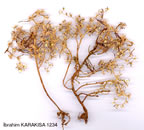| Crassulaceae |
 Sedum hispanicum var. semiglabrum |
| Sedum L. Sedum hispanicum L. var. semiglabrum FRÖDER. Ömür: Çok veya Tek yıllık Yapı: ot Hayat formu: İlk çiçeklenme zamanı: 6 Son çiçeklenme zamanı: 6 Habitat: kireçtaşı kayalar Minimum yükseklik: 1700 Maksimum yükseklik: 2200 Endemik: - Element: İran-Turan Türkiye dağılımı: D. Anadolu Genel dağılımı: Gürcistan, Lübnan Bulunduğu kareler:A1 A2 A3 A4 A5 A7 A8 A9 B1 B2 B5 B6 B8 B9 B10 C2 C4 C5 C6 C9 C10 |
| S. hispanicum L., Sp. PI. ed. 2:618 (1762). Simple or much-branched, erect or ascending annual or perennial; sterile shoots sometimes present; flowering stems 5-15 cm. Leaves linear, semi-terete to oblong, ± plane, 4-20 mm, glandular-hairy, green or glaucous. Inflorescence a lax to ± dense, 2-4-branched cyme, each branch with 1-8 flowers; peduncles glabrous or more usually glandular-pubescent above. Flowers 5-9-merous, subsessile; sepals c. 2 mm, acute, glandular-pubescent; petals white with pink mid-vein, 4-5 mm; stamens 10, anthers purple; follicles glandular-pubescent or glabrous, white or pale pink, stellate-spreading. 1. Flowers 6-7(-9)-merous; stems much branched; styles 1 mm or more 2. Leaves semi-terete, oblong to linear var. hispanicum 2. Leaves plane, narrowly elliptic var. planifolium 1. Flowers 5-merous; stems simple below inflorescence; styles c. 0.5 mm var. semiglabrum var. hispanicum. Syn: S.glaucum Waldst. & Kit., PI. Rar. Hung. 2: 198 (1805); S. sexfidum Bieb., Fl. Taur.-Cauc. 1:198 (1808); S. eriocarpum Sm. in Sibth. & Sm., Prodr. Fl. Graec. 1:310 (1836); S. hispanicum L. var. buxbaumii Gris., Spic. 324 (1843); S. orientale Boiss., Diagn. ser. 1(10): 17 (1849); S. armenum Boiss., Diagn. ser. 2(2): 61 (1856); S. glaucum Waldst. & Kit. var. leiocarpum Boiss., Fl. Or. 2:789 (1872); S. glaucum Waldst. & Kit. var. eriocarpum (Sm.) Boiss., loc. cit. (1872); S. longibracteatum Fröder. in Ark. Bot. 5(1): 189 (1859)! Ic: Reichb., Ic. Fl. Germ. 23: t. 51 (1899); Fiori, Ic. Fl. Ital. f. 1732 (1899). Fl. 4-7. Screes, limestone rocks, s. 1.-2400 m. Described from 'Spain' though almost certainly originating from elsewhere. Scattered throughout Anatolia, Islands. Al Çanakkale: Dardanelles, Sint. 1883:635! A2(A) Istanbul: Proti (Kinaliada) 19 v 1897, Azn.! A3 Bolu: 12 km N. of Bolu, nr. Çağlikdere, 1100 m, Kühne 816! A4 Zonguldak: Kastamonu to Araç, 750 m, Tobey 1921! A5 Amasya: Tosya, Giaurdagh (Gavur Da.), Sint. 1892:4230! A7 Trabzon: Hamsiköy, 1230 m, Hub.-Mor. 14490. A8 Rize: Ikiz-dere, 1000 m, Stainton 8392! A9 Kars: Selim to Sarikamiş. 1900 m, D. 30672! Bl Izmir: nr. Smyrna (Izmir), vi 1877, Ball! B2 Kütahya: 6 km from Simav to Simav Da., 1300 m, Coode & Jones 2644! B5 Kayseri: Kisge at W. foot of Bakir Da., 1300 m, D. 19211! B6 Maraş: Berit Da., to Elbistan, 1800 m, Stn..& Hend. 5618! B10 Ağri: 3 km E. of Doğubayazit, 1750 m, D. 43941! C2 Muğla: Girdev Da., 2400 m, D. 14997! C4 Içel: 43 km N. of Mut, 1600 m, Sorger 66-34-1! C5 Niğde: Ala Da., Emli Gorge, 2000 m, Parry 229! C6 Hatay: Kusliji Da., 1500-2000 m, Haradj. 2536 (type of S. longibracteatum)! Is: Samos, nr. Ambelos, Fors.-Maj. 370! Ikaria, Runemark & Snogerııp 12571. S. & C. Europe, N. Iran, Caucasia, Lebanon, Palestine.var. planifolium Chamberlain in Notes R.3.G. Edinb. 31: 325 (1972). Fl. 7. Rocky slopes, 1900-2100 m. Type: Turkey B2 Kütahya: Murat dağ above Gediz, above Kesik Söğüt, 1900-2000 m, 5 vii 1962, Davis & Coode, D, 36839 (holo. E!). W. Anatolia. B2 Kütahya: Murat Da., above Kesik Söğüt, 1900-2100 m, D. 36824! Endemic. Only known from the type locality. var. semiglabrum Froder., op. cit. 3:82, f. 650-658 (1932). Fl. 6. Limestone rocks, 1700-2200 m. Type: [Turkey A8 Gümüşane/Erzurum] inter Baiburt et Erzurum in aridis elatis Tachkenfom (Taşköprü), Huet du Pavilion 1853 (iso. K! BM!). E. Anatolia. A8 Erzurum: Aras River gorge, 1700 m, Tobey 2109! B9 Van: Van to Ercek, 2100 m, D. 44413! C9 Siirt: Körkand Da., 1700 m, Frödin 1936:102! (as S. palaestinıım Boiss.)! C10 Hakkari: Şemdinli, 24 v 1966, Eiselt! Georgia, Lebanon. Ir.-Tur. element. A very variable species, especially with respect to the number of flower parts and the degree of glandulosity. S. longi-bracteatum is an extreme variant which is virtually glabrous and in which each flower is subtended by a long 'bract'. However, there is much variation in 'bract' length, even on the type sheet, and similar forms are to be found among European material. For these reasons, I have treated S. longibracteatum as a synonym of S. hispanicum s.s. Of the infrageneric taxa already described within S. hispanicum, var. semiglabrum appears to be the most distinct. This variety approaches S. hewittii but the latter may be distinguished by its larger, obtuse sepals and yellow anthers. |